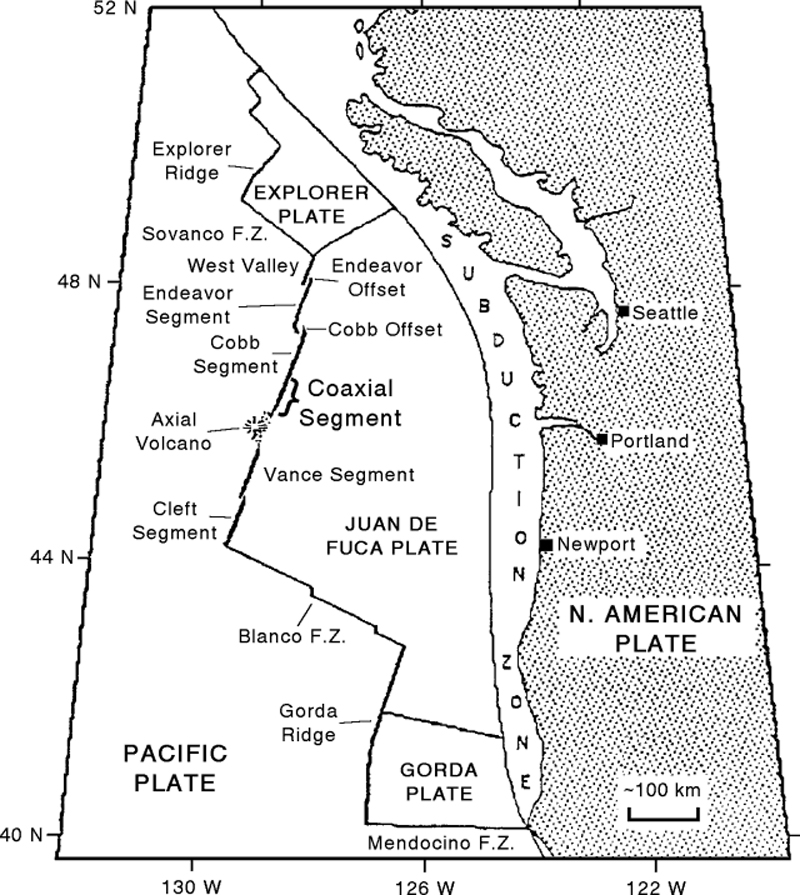Report on East Blanco Depression (Undersea Features) — December 1993
Bulletin of the Global Volcanism Network, vol. 18, no. 12 (December 1993)
Managing Editor: Edward Venzke.
East Blanco Depression (Undersea Features) T-phase data indicates possible eruption along the Blanco Fault Zone
Please cite this report as:
Global Volcanism Program, 1993. Report on East Blanco Depression (Undersea Features) (Venzke, E., ed.). Bulletin of the Global Volcanism Network, 18:12. Smithsonian Institution. https://doi.org/10.5479/si.GVP.BGVN199312-331060
East Blanco Depression
Undersea Features
44.267°N, 129.879°W; summit elev. -3000 m
All times are local (unless otherwise noted)
"The NOAA Real-Time T-Phase Monitoring System recorded significant seismicity in mid-January [1994] from the East Blanco Depression of the Blanco Transform Fault Zone, ~65 km SE of the JDFR/Blanco intersection (figure 1). The event was confirmed by Navy SOSUS operators at Naval Facility Whidbey Island. The East Blanco Depression is believed to be a pull-apart basin based on extensional structures interpreted from SeaBeam bathymetry and SeaMARC-II sidescan imagery. See Embley and Wilson (1992) for additional information about the area with bathymetric and structural maps.
"The recorded T-phases [seismic phases below 1 Hz that traveled through the ocean] were very similar to those recorded from the eruption in January 1993 at Socorro Island, off the Mexican coast (18:01), and unlike earthquake swarms typically recorded from the Blanco Fracture Zone. Possible precursors (or earlier activity) were noticed as early as 10 December 1993, but intense activity began on 10 January. On some days, intermittent low-frequency tremor-like signals were very common, rising above the detection level for 3-5 minutes at intervals of 10-15 minutes; other days there were very few signals. The overall acoustic energy was considerably greater than that recorded from the Coaxial Segment last June, and the similarity to the Socorro Island event makes seafloor extrusion a real possibility. Discrete earthquakes embedded in the tremor signals allowed for time-delay calculations from three SOSUS arrays, which resulted in consistent locations near 44.2°N, 129.7°W, on the flank of the East Blanco Depression. Due to the emergent nature of the acoustic signals, the error associated with this location could be quite large (± 5 km). This intense seismo-acoustic activity from the East Blanco Depression decreased suddenly on 16 January, apparently associated with a series of relatively large earthquakes from the area, which may be related. No significant migration of activity was observed; only minor activity has been recorded since that time.
"There are currently several research cruises that may be diverted to respond to the event at some level. NOAA Ship Discoverer will be at the site 27-29 January to conduct oceanographic sampling and possibly bathymetric resurveys. RAFOS floats are available to seed hydrothermal plumes, if detected, to allow later investigation. The Univ of Washington research vessel Thomas Thompson will transit the area in Mar. The Oregon State Univ research vessel Wecoma will be in the area in April. NOAA Ship Surveyor may spend three days on-site in May. Numerous other cruises involving NOAA, Woods Hole, Univ of California (Scripps), and Navy vessels will begin in June."
Reference. Embley, R. W., and Wilson, D. S., 1992, Morphology of the Blanco Transform Fault Zone-NE Pacific: Implications for its tectonic evolution: Marine Geophysical Researches, v. 14, p. 25-45.
Further References. Dziak, R.P., Fox, C.G., Embley, R.W., Lupton, J.E., Koski, R.A., Evans, L.J., and Chadwick, W.W., 1994, Detection and response to a probable volcanogenic T-wave event swarm on the Western Blanco Transform Fault Zone (abs.): EOS v. 75, p. 717.
Geological Summary. The East Blanco Depression (EBD) is a pull-apart basin within the western Blanco Transform Fault Zone, a right-lateral transform fault that links the Juan de Fuca Ridge and Gorda Ridge (Dziak et al., 1996). In January 1994 a T-wave swarm suggested eruptive activity. Investigations later that year were inconclusive regarding an associated eruption, but found an active hydrothermal mound on the flanks of a pillow-lava volcano. Dziak et al. (1996) considered the EBD to have been the site of recent seafloor eruptions.
Information Contacts: C. Fox and W. Chadwick, NOAA Vents T-phase Project.


